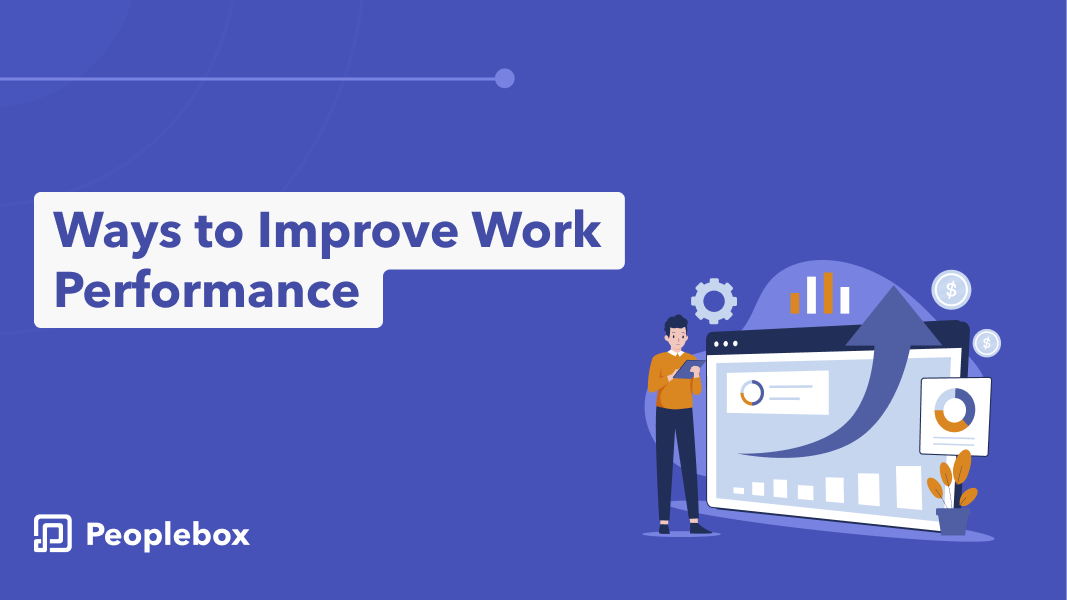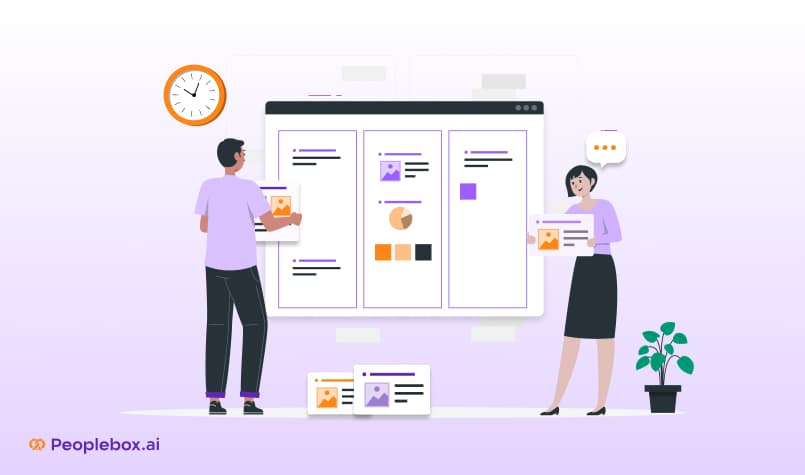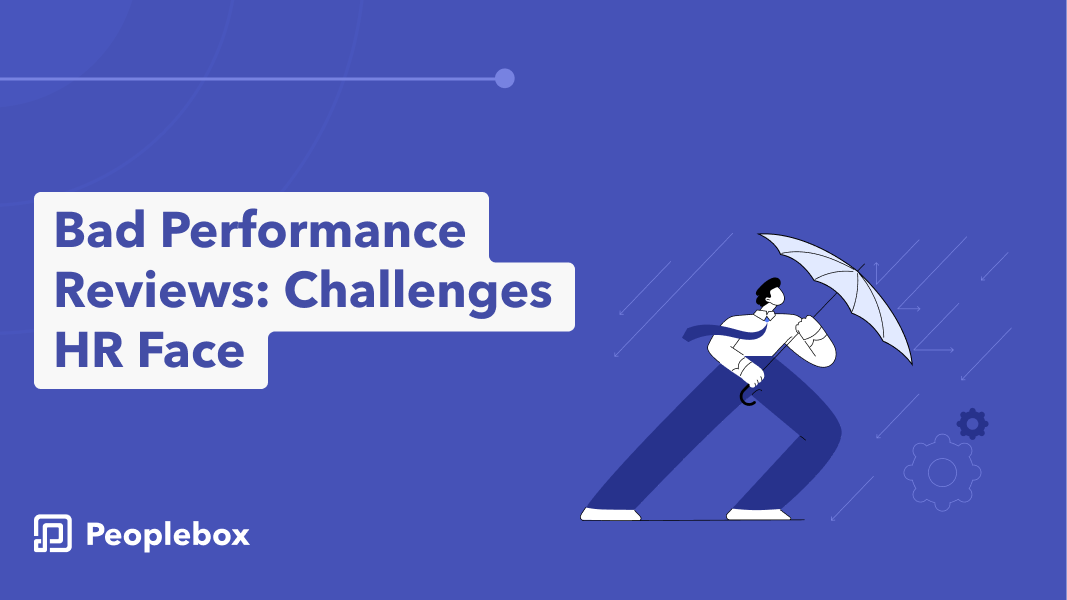Is your team’s productivity stuck in neutral while 2025’s business challenges race ahead? You’re not alone.
Even your A-players are struggling to keep pace as competition heats up and workplace demands shift beneath their feet. The relentless grind for results is backfiring—draining energy and crushing output instead of boosting it.
Here’s the wake-up call: in today’s shape-shifting professional landscape, wellness isn’t fluffy HR talk—it’s your secret weapon for sustained performance. The most successful companies have cracked the code: ways to improve work performance start with aligning personal vitality and professional ambition.
Forget outdated productivity hacks. This guide delivers six game-changing strategies that actually work in 2025’s reality. From communication overhauls to recognition systems that trigger genuine motivation, we’re about to transform your team from merely functioning to genuinely thriving.
Ready to spark a productivity revolution? Let’s dive in.
Ways to Improve Employee Performance

Plans indeed are vital to a company’s success, but they stand nothing without the involvement of the workforce. A business can create the world’s greatest trillion-dollar plan, however, if its employees show no effort, it is of no use. Take any business giant and you’ll find a chunk of their investment going into employee improvement programs. Here is why:
- It adds brilliance to their skills and expertise. Consequently, they get the right knowledge to steer the helm in the direction of the broader company goals.
- Employees’ development and well-being create a culture of continuous learning, engagement, and innovation.
- Increased productivity, enhanced employee satisfaction and retention, and improved organizational performance.
- Empower employees to reach their full potential.
- Valuing and prioritizing the growth and well-being of employees cultivates a motivated, engaged, and high-performing workforce. This subsequently reduces turnover.
- Builds a positive employer brand, attracting skilled professionals seeking growth opportunities and a fulfilling work environment.
1. Provide your employees with long-term career support
A study by LinkedIn found that 92% of employees say they would stay at a company longer if it invested in their career development.
Organizations demonstrate their commitment to their employees’ growth and success by providing long-term career support. This not only boosts employee engagement and satisfaction but also fosters loyalty and lowers retention.
Employees who receive ongoing support and development are better prepared to take on new challenges, contribute to the organization’s goals, and excel in their careers.
a. Implement mentorship programs or career coaching
Pair employees with experienced mentors who can provide guidance, advice, and support in navigating their career paths. This mentorship relationship fosters professional growth, helps employees develop new skills, and expands their networks.
b. Offer opportunities for internal mobility and promotions
Employees who have made an internal move have a greater chance of staying with their company, up to 75%. Thus, create a culture that encourages internal mobility, allowing employees to explore different roles within the organization. Provide clear pathways for advancement and ensure that promotions are based on merit and performance. This not only motivates employees but also enhances their long-term career prospects within the company.
c. Offer training and development opportunities
Identify skill gaps and provide relevant training programs to bridge them. This could include technical skills training, leadership development programs, or specialized workshops. You could also work on creating customized performance improvement plans to help them grow. By investing in employee training, you empower them to acquire new skills and stay updated with industry trends, increasing their value to the organization.
d. Encourage continuous learning
Foster a culture of learning by offering workshops, webinars, or online courses that employees can participate in. Encourage them to take ownership of their professional development and provide resources and support to facilitate their learning journey. This continuous learning mindset ensures employees have the knowledge and skills needed to adapt to changing circumstances.
2. Create an environment of feeling valued and heard
As humans, we have this innate desire to feel valued and heard. Feeling valued and heard taps into our basic human need for belonging. And once we truly feel that we belong to a community, we sweat out to make that community grow.
So, make your employees feel heard and valued. This is one of the best ways to improve work performance.
a. Encourage open communication
Establish a culture that promotes open and transparent communication. Encourage employees to share their ideas, concerns, and feedback without fear of judgment or reprisal. This creates a sense of psychological safety, enabling employees to freely express their thoughts and contribute to the organization’s growth.
b. Recognize and reward achievements and efforts
Regularly acknowledge and appreciate employees’ accomplishments and efforts. Recognize their contributions publicly, whether through team meetings, newsletters, or dedicated recognition programs. This not only boosts morale but also reinforces a culture of appreciation and motivates employees to continue performing at their best.
c. Empower employees through delegation
Trust your employees by delegating meaningful tasks and responsibilities. Give them autonomy and ownership over their work, allowing them to showcase their skills and capabilities. Empowerment fosters a sense of ownership and engagement, as employees feel valued for their expertise and contributions.
d. Gather feedback from employees
Actively seek feedback on various aspects of the work environment, such as communication channels, teamwork, and leadership effectiveness. This can be done through surveys, focus groups, or one-on-one conversations. By involving employees in shaping the work environment, you demonstrate that their opinions are valued and contribute to positive change.
e. Analyze survey results and implement necessary changes
Carefully analyze the feedback received from employees and identify areas for improvement. Take action based on the feedback to address concerns, resolve issues, and implement necessary changes. Communicate these changes transparently to employees, showing that their feedback has been heard and acted upon.
3. Embrace a continuous feedback process
A study by Gallup found that employees who receive regular feedback are 3.9 times more likely to be engaged in their work.
Creating a culture of continuous feedback is vital for fostering growth and enhancing performance within organizations. By providing ongoing constructive feedback aligned with goals and utilizing OKRs, organizations can empower employees to continuously improve. Additionally, implementing regular coaching sessions further supports their development and drives overall success.
Emphasizing both strengths and areas for improvement while addressing issues promptly leads to a proactive and productive work environment.
a. Goal-oriented ongoing constructive and specific feedback
Instead of relying solely on annual performance reviews, encourage regular feedback that is specific, constructive, and aligned with individual and organizational goals. This helps employees understand their strengths, areas for improvement, and how their work contributes to overall objectives.
b. Get to the core of the problems with an OKR approach
Use OKRs to set clear goals and metrics for employees. This approach facilitates discussions around progress, challenges, and opportunities for growth teamed with a unified direction for everyone. By aligning feedback with OKRs, employees receive targeted feedback that focuses on outcomes and continuous improvement.
c. Give realistic feedback that enhances productivity and performance
Provide feedback that is realistic and actionable, focusing on both achievements and areas for improvement. Steer clear of feedback like ‘You need to improve performance’. Instead, focus on solutions and ways to improve performance. This helps employees understand what they are doing well and where they can enhance their skills or processes to enhance productivity and overall performance.
d. Implement regular and timely check-ins and coaching sessions
Schedule regular check-ins and coaching sessions with both managers and team members, to discuss progress, and challenges, and provide guidance. These sessions allow for open communication, addressing questions, and providing real-time feedback. Regular check-ins also enable managers to offer support, recognize accomplishments, and identify any roadblocks hindering performance.
e. Balance positive feedback with areas for improvement
While acknowledging achievements and strengths, also address areas for improvement. Balance positive feedback with constructive feedback to create a well-rounded perspective. This helps employees understand their development areas while recognizing their contributions.
f. Address issues promptly to prevent escalation with an intelligent platform
Utilize an intuitive feedback platform, like Peoplebox.ai, to streamline the feedback process and address issues promptly. A good platform will enable managers and employees to provide feedback in a timely manner, ensuring prompt action and preventing problems from escalating. This promotes a proactive approach to problem-solving and fosters a culture of open communication.
For example, when using Peoplebox.ai, you can set OKRs, track progress, give feedback in real-time and also conduct performance reviews directly from Slack.
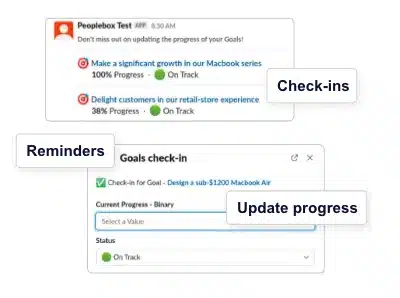
g. 360-degree feedback
360-degree feedback is a valuable tool that allows organizations to collect feedback from multiple sources, including peers, subordinates, and supervisors. This comprehensive approach promotes a well-rounded assessment of an employee’s performance, providing valuable insights for personal and professional development. Organizations can gain valuable insights into individual and team dynamics, enhance communication and collaboration, and support employee growth and development.
You must also focus on soliciting feedback from various perspectives. This helps gain a more holistic view of an employee’s strengths, areas for improvement, and overall impact within the workplace. The inclusion of peers and subordinates in the feedback process allows for a comprehensive evaluation that goes beyond just the perspective of a direct supervisor. This also encourages employees to reflect on their actions and behaviors, increasing self-awareness and identifying blind spots that may have gone unnoticed.
To ensure an effective 360-degree feedback process:
- Establish clear guidelines and specific evaluation criteria. This provides structure and ensures that feedback is meaningful and actionable.
- Confidentiality is crucial for a successful 360-degree feedback process. Employees should feel comfortable providing honest feedback, knowing that their responses will be kept confidential.
- Clearly communicate the purpose and benefits of 360-degree feedback to employees. This helps them understand the value of the process and encourages their active participation.
- Aggregate and analyze the feedback data to identify trends and areas for organizational improvement. This feedback can inform training programs, policy changes, and overall enhancement of the work environment.
4. Set clear performance expectations
Setting clear performance expectations is vital for improving productivity in organizations. It aligns efforts, clarifies priorities, motivates employees, optimizes resource allocation, and fosters feedback and development. Clear performance expectations create an environment where employees can thrive, resulting in increased productivity and overall success.
a. Establishing measurable and realistic goals using OKRs
Use OKRs to set clear and measurable performance goals. OKRs provide a framework for aligning individual and team objectives with the overall organizational goals. By setting specific and realistic targets, employees have a clear understanding of what is expected of them and can work towards achieving those goals.
b. Stay in control of employee and team performance with a transparent platform
Leverage a platform like Peoplebox.ai to effectively track and manage employee and team performance. Managers can monitor progress, provide feedback, and identify areas where support is needed. A platform brings transparency which promotes accountability and helps individuals stay focused on their performance goals.
c. Communicate expectations and outcomes effectively on a privacy-first platform for 1:1s
By using a privacy-first platform for conducting 1:1 meetings, organizations can ensure confidential and open discussions. This provides a secure space for open and honest communication, allowing managers to clearly communicate expectations and outcomes.
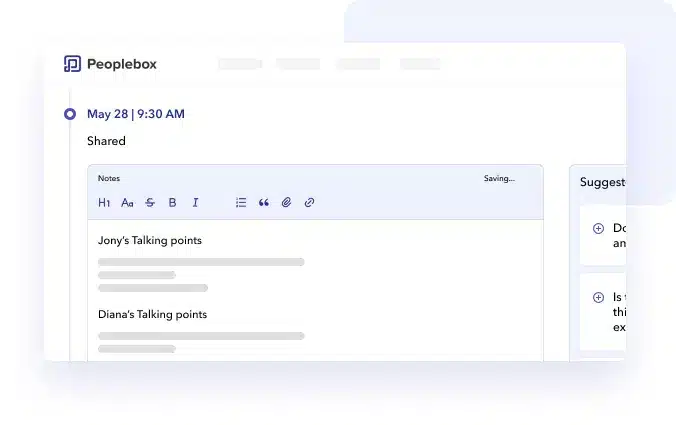
With tools like Peoplebox.ai, you can use features like notes. They help team members take down the points they’d like to discuss during their 1:1 call with the managers. It facilitates meaningful discussions about performance, progress, and any challenges or support needed to meet expectations. What’s more, managers with the help of admin access can view all the points beforehand and prepare well for the 1:1 meetings with the team members.
5. Streamline work processes and efficiency
No workspace is free of flaws and obstructions. But this doesn’t mean we should let these hinder performance. Streamlining work processes and enhancing efficiency are crucial to improve employee productivity. By identifying and eliminating bottlenecks, prioritizing projects based on feedback and reviews, and leveraging technology and automation, organizations can optimize workflows and drive greater efficiency.
a. Identify and Eliminate Bottlenecks
Conducting process audits is essential for identifying areas of inefficiency within work processes. By analyzing workflows and seeking input from team members, you can pinpoint bottlenecks that impede productivity. Once identified, steps can be taken to remove these obstacles, streamlining the overall process.
b. Prioritize Projects Based on Conversations, Feedback, and Reviews
Effective project prioritization is key to maintaining focus and productivity. Engaging in consistent conversations with team members, actively seeking feedback, and conducting regular project reviews, can help align efforts with strategic goals. Prioritizing projects based on input from stakeholders ensures that resources are allocated to the most impactful and time-sensitive tasks.
c. Leverage Technology and Automation
Embracing productivity tools and software can significantly streamline tasks and boost efficiency. From project management platforms to collaboration tools, there are numerous technological solutions available that improve employee productivity. Automating repetitive processes through the use of workflow automation tools not only saves time and effort but also reduces the risk of errors and eliminates redundancies.
6. Promote employee engagement and motivation
Employee engagement and motivation are fundamental pillars of a thriving work culture. By implementing strategies to enhance engagement, you create a motivating work environment and promote work-life balance. This helps cultivate a workforce that is driven, fulfilled, and poised for success. Investing in employee engagement and motivation yields significant returns by fueling productivity, enhancing job satisfaction, and fostering a positive and dynamic work culture.
a. Enhance Employee Engagement
Empowering employees through involvement in decision-making processes is an impactful way to enhance employee engagement. By seeking their input and ideas, organizations demonstrate trust and value their employees’ perspectives, fostering a sense of ownership and commitment.
Employee engagement initiatives, such as team-building activities, promote collaboration, trust, and camaraderie among team members. These initiatives strengthen the bond within the team, boost morale, and should be a part of the employee experience journey.
b. Foster a Motivating Work Environment
Creating a motivating work environment is essential for driving employee engagement and productivity. One effective approach is to offer performance-based incentives and rewards. Recognizing and rewarding employees‘ exceptional performance or achievements reinforces their motivation and encourages them to excel further. Performance-based incentives, such as bonuses or public recognition, provide tangible incentives for employees to give their best.
Additionally, celebrating milestones and accomplishments as a team plays a crucial role in fostering motivation. By acknowledging collective successes, organizations boost morale and reinforce a positive work culture. This fosters a sense of pride and camaraderie among team members, motivating them to continue working towards shared goals with enthusiasm and dedication.
Conclusion
In the dynamic and competitive world of business, the success of a company hinges on the quality and performance of its workforce. To thrive in this environment, organizations must prioritize employee engagement and improvement. And this gains further importance in the present time when recession and mental burnout is creeping in. Fear of losing the job, work pressure, and poor lifestyle, all these things contribute to the fall of a company. In such times, organizations must know ways to improve work performance.
By prioritizing these measures organizations can create a productive and thriving work culture. To effectively implement and manage these strategies, utilizing a comprehensive tool like Peoplebox.ai can greatly enhance the process.
Peoplebox.ai offers a privacy-first platform that streamlines performance management, enabling seamless communication, goal tracking, and performance evaluation. It empowers organizations to track progress, provide timely feedback, and foster continuous improvement for employee development.Investing in employee performance not only improves employee productivity but also contributes to the overall growth and success of the organization. By prioritizing the growth and well-being of employees, companies create a win-win situation. It inspires an environment where both the organization and its workforce thrive together in harmony.

